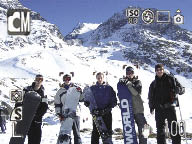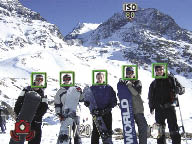The most notable improvement to the SD800 IS from the popular SD700 IS is the inclusion of the equivalent 28mm to 105mm zoom lens. Canon can now compete with Panasonic's FX line of cameras in producing digital point-and-shoots that include true wide-angle potential. This characteristic, coupled with a few other exciting upgrades, makes the SD800 IS look good on paper. Let's hope that my rigorous tests find that it functions as well or better than its predecessors.
The main selling points of the Canon SD800 IS are:
- 7.1 Megapixel CCD
- 3.8x zoom
- Wide angle 28mm lens with optical image stabilizer
- DIGIC III advanced noise reduction
- Face detection AF/AE
- Safety zoom
- ISO 1600
- 2.5” High resolution LCD
- 17 shooting modes
- VGA Movie mode with sound at 30 fps
- A small range of accessories including an underwater case
In order to distinguish the SD800 IS from the SD700 IS (which was only released seven months prior to the pre-Photokina September 2006 launch of the SD800 IS), we should focus on these characteristics:
- 7.1 Megapixel CCD as opposed to the 6.0 Megapixels on the SD700 IS
- 3.8×28mm to 105mm (equiv) versus 4×35mm to 140mm
- DIGIC III image processor versus DIGIC II processor in the SD700 IS
- New face detection technology
- Higher resolution LCD
- 1600 ISO as opposed to 800 ISO
- Higher movie recording file size limit (4GB versus 1GB)
- 12% improvement in battery life
- Supports SDHC memory cards
- The much anticipated aquarium special scene mode
The Camera and the User Interface
The most exciting upgrade to the SD800 IS is that the buttons (which were too small on its predecessor) have been slightly enlarged to facilitate a better operating experience. The large 2.5” LCD keeps the body of the camera from being “tiny,” although it is similar in size and appearance to the majority of similar-spec'd point-and-shoots in its category. However, it can still be considered ultra-compact, weighing in at exactly eight cubic inches.Figure 1
The other noticeable upgrades in this model are the absence of the black plastic rear panel, the main power switch on the top of the body and the slightly boxier styling.Figure 2 Like most other cameras in the Digital Elph family, the SD800 IS feels well-crafted when handled. The tactile feedback is comfortable, while the metal shell does not feel flimsy.
As mentioned above, the camera features a retractable new f2.8 to 5.8 wide-angle lens. This lens is a huge improvement when shooting indoors. The downside of all cameras in this ultra-compact category is that none of them have a threaded lens. I will complain about this until the day that I die. I understand why this is not part of the package, but I still think that Canon should lead the way in making it possible to shoot with filters on the lens.
The optics on the SD800 IS are advanced. In addition to the wide-angle capabilities of the lens, it boasts a well-manicured optical image stabilizer. This is what the “IS” stands for in the product's name. Sensors inside the camera detect movement that could potentially create blur, and a lens element compensates for this movement and shifts in order to focus on the subject. As a result, slower shutter speeds can be used in lower light situations. In my tests, I was gaining at least two stops as a result of the optical image stabilization. This is a concrete example of the benefits of digital cameras over the analogue predecessors.
Many cameras in this ultra-compact category eliminate the viewfinder from their design. The SD800 IS does not do this, which is a plus. However, the screen is beautiful on this camera. It has 207,000 viewable pixels crammed into its 2.5” frame, so it's very sharp and bright. Even when used outdoors in direct sunlight, the screen proved bright enough to provide the user with feedback.
As we are used to with previous models of this Canon user interface, the main mode dial is at the top right corner of the back panel of the camera. The main modes are: playback, auto record, manual record, SCN (the scene selection module) and movie.
Below this mode dial is the unfortunate and hardly used ”Direct Print” button. The inclusion of this in the physical body design continues to baffle me. Although I understand that I am not the average consumer of such a camera in terms of skill level, I still think that this button is an unnecessary design flaw.
On the same back panel is the circular iPod-like menu controller that we are accustomed to on Canon cameras. Below this four-way controller there are two buttons: “DISP” and “MENU”.
The top of the camera includes the shutter release/zoom controller and the on/off switch. A new and exciting feature in the SD800 IS is that the on/off switch is illuminated while on.Figure 3 The camera's microphone and speaker are also on top.
In addition to the metal tripod mount, the bottom of the camera houses the battery and SD slot door. The majority of the camera is metal and feels sturdy in hand.Figure 4 However, this door is flimsy — another serious design flaw. This plastic door will surely be one of the first things to break on the body of the SD800 IS.
One other aspect of the design of the camera that we should mention is the battery. Canon advertises that the new battery will last 270 shots. This is impressive insofar as the camera has the typically power-hungry image stabilization. This battery life is a 12% upgrade from the SD700 IS. The SD800 IS uses the tried and true NB-5L battery pack. As standard for Canon and all ultra-compacts, the camera also comes with a simple compact charger that plugs directly into the wall. I love this combination of battery and charger that Canon pioneered years ago. Although the batteries are relatively expensive ($45 USD) they take up a very small footprint, allowing the camera to be thinner than if AAAs were used. Moreover, the battery recharges quickly in 2.5 hours.
The user interface of Canon's ultra-compact line has become more streamlined and concise with every release. The SD800 IS features all the fancy characteristics of earlier models, including slide show transitions, color swap options and a motion orientation sensor that rotates the display in playback to landscape or portrait depending on how you view the image.
If you have previously owned a Powershot, you will feel very comfortable with the menu interface of the SD800 IS. If you are new to the Powershot user interface, it's not hard to understand.
Differentiating between manual and automatic modes is important. In automatic, the user only has control over the image size and quality variables. Manual controls, on the other hand, offer the user a plethora of imaging options. Some of my favorite controls in this model are the color palette options: Canon has made it incredibly easy to adjust contrast, saturation and sharpness, as well as red, green, blue and skin tones.
More general camera settings are in the set-up menu. Most notable here are the new additions of the AiAF face detection protocol. An additional “My Camera” menu allows you to customize the startup screen, beeps and the horrid phony shutter sound. Canon also makes it relatively easy to upload your own photos for the start-up screen and your own sounds for menu and shutter sound effects. These are a few of the personalized options that Canon has included in the package to allow users to make their SD800 IS feel unique.
Photographic Tests
As we'll see, I believe the SD800 IS takes very good photographs. However, as with many of the current ultra-compact point-and-shoot digital cameras, some sacrifices have been made to compensate for the size. On the other hand, the movie capture mode continues to be incredible. First we'll look at the quality of still images made by the SD800 IS and then at the movies it makes.
The camera does a very nice job with a standard macro photograph.Figure 5 The closest focal length the SD800 IS can handle is 3 cm. Canon has become known for a certain kind of macro photograph that looks smooth. Some users will consider this a negative characteristic. However, the macro images are not blurry. Rather, they simply look smooth. There is no other way to explain it. The SD800 IS is no exception to this quality of the Canon line.
The night ISO test turned out as expected. In the menu I turned on the long shutter feature. ISO 80 and 100 look fine, but as soon as we look at ISO 200 and 400, a large amount of grain appears. Shooting at 800 or 1600 at night is not recommended.Figure 6, Figure 7
The optical image stabilization works wonderfully, as these images portray.Figure 8, Figure 9 In these images, the camera used 1/6-second shutter speed. The difference is obvious, and the effectiveness of the optical image stabilization is apparent. My tests indicate that I was receiving at least a two-stop advantage from this image stabilization.
One of the downsides of having a 28mm wide-angle lens on such a compact camera is that the user will encounter moderate barrel distortion. Figure 10 details this 1.2% distortion and shows slight corner fuzziness.Figure 10 This phenomenon is obviously exaggerated by not holding the camera perpendicular to the horizon plane.
“FD” is Canon's acronym for face detection, a new quality in the SD800 IS. Essentially, FD enables the camera's auto focus to easily recognize and focus on the faces in a portrait instead of another subject in the foreground or background. The metering system is also involved, ensuring that your subject is properly exposed. Although I was suspicious prior to testing this feature, I am happy to report that it actually works. The camera actually detects faces, both toddlers and adults, exposes them, and focuses them both accurately and appropriately.Figure 11, Figure 12
The standard daylight ISO test has nothing out of the ordinary to report for a tiny, high pixel count chip. Everything looks very snappy through ISO 200, but we start losing some minor detail at ISO 400.Figure 13 Like most compacts, ISO 800 and 1600 are significantly grainy.Figure 14 Although I am glad that Canon included the ISO 1600 option in the SD800 IS, I won't be using it unless the situation is dire.
The problem with the SD800 IS at ISO 800 and ISO 1600 is complicated by the fact that this is one of the first models that I have reviewed that has obvious noise reduction artifacts at these higher ISO settings. This means that the chips have been manufactured to specifically attempt to reduce the noise, thus losing detail. However, in the case of ISO 800 and ISO 1600, there is an obvious watercolor effect that results in the fine, low-contrast detail from the noise reduction filter.
Besides the standard automatic white balance, the SD800 IS has five white balance presets: daylight, cloudy, tungsten, fluorescent and fluorescent H. While shooting outdoors, the automatic WB works great. However, inside is a different story and using one of these presets will help dramatically if you are concerned with proper color correction.
Like most ultra-compacts, the SD800 IS has a built-in flash. However, this one is slightly underpowered: Its working range is .5m to 4.0m at 28mm and .5m to 2.0m at 105mm. If the user turns the red-eye reduction off, flash recycling will be much quicker. Also, the AF illuminator works very well at distances up to two meters.
The downside of this particular flash is that it — as with most cameras in the ultra-compact category — suffers from a horrible red-eye problem. Luckily for pro users, getting rid of red-eye is easy with recent versions of Adobe Photoshop. However, for the layperson, this problem will be persistent and annoying.
In the midst of my testing I also found these slightly negative results:
- The SD800 IS will clip highlights when shooting in bright, high-contrast situations. Of course, the user could use AE compensation to bring down the exposure a little, but most point-and-shoot users will not want to futz in this manner.
- The SD800 IS exhibits some very mild blue and purple fringing. This is rare, but it happens in overexposed areas of images.
- As mentioned above, the result of having such a wide lens is that corner sharpness is compromised. It is not a huge problem in the case of the SD800 IS, however it is slightly noticeable.
Movie Mode
In the past, Canon has capped the individual movie capture size at 1GB. When recording at the highest quality, this meant that the longest recordable clip would be eight minutes. With the inclusion of the DIGIC III, the allowed file size is now 4GB! Consequently, users are able to record over 32 minutes of data at 640×480 at 30 frames per second with sound. This is great news for those of us who understand the value of movie recording on ultra-compact digital cameras.
One of the other exciting characteristics of the SD800 IS movie mode is that users are now able to record video at “Fast Frame Rate,” which essentially lets you record 320×240 at 60 fps, a very exciting feature for those of us who shoot movies of sporting events. Moreover, OIS applies to movie mode as well. As a result, moving image files are considerably less shaky than Mini DV recordings.
As with previous Canon models, movies are saved in AVI format, using the M-JPEG codec. Optical zoom does not apply during movie mode, but digital zoom still performs.
As I've said a million times, the digital movie recording on these ultra-compact cameras is amazing. My life changed when I bought my first one. The quality of the movies that Canon cameras are making is astounding compared to similarly priced DV cameras that use tape instead of flash cards. Now that the SD800 IS allows users to capture more than 30 minutes of footage at once, there is no reason for consumers to use bulky, non-HD Mini DV cameras.
Conclusions
With the new 28mm to 105mm lens, the SD800 IS is a strong competitor in the ultra-compact field. This is the biggest advantage of this model compared to previous Canon releases. There are many practical advantages to this focal range and I am happy with Canon's new commitment to a wide-angle point-and-shoot with the SD800 IS.
As with most previously released Powershot models, the performance is excellent. It is ready to point-and-shoot in just one second. Focusing speeds are good and shutter lag isn't too noticeable. Battery life is good and still above average for most cameras in its class.
Image quality is good and very similar to past Canon Powershot releases. Color accuracy and exposure are good. Noise levels are nice through ISO 400. However, we saw some intense noise and grain cover-up in the higher ISOs, and the flash is a little too red-eye-friendly. These characteristics coupled with the corner softness and occasional purple fringing represent the only negative aspects of the SD800 IS's image quality.
The body is sleek and stylish. It is made of metal and I imagine the innards to be well-protected sturdy. The exception to this is the battery/SD door, which is made out of flimsy plastic. The controls are well placed. There is one button — “Direct to Print” — that is ridiculously stupid and unfortunately given its own place in the product design. The image stabilization is a welcomed feature. The movie mode continues to be stunning.
The only other cameras in the same class as the Canon's Powershot series are Panasonic's FX line. Both brands have good and bad characteristics. However, the layperson will notice very little difference.
All in all, the Canon Powershot SD800 IS is a great point-and-shoot camera. What the user receives on one hand with the wider lens, he or she loses with the slightly reduced image quality. Nevertheless, this new addition to the Canon Powershot line is welcomed. This is a great timestamp to digital imaging and moving image creation. This camera is something that I would recommend to anyone looking for a small point-and-shoot digital camera.
What I appreciated:
- Optical image stabilization
- Good color calibration
- Good image quality through ISO 400
- Reliable exposure system
- Decent macro mode
- Easy to use user interface
- Useful wide-angle lens at 28mm to 105mm
- Compact, well-manicured body
- Large, 2.5” LCD with great resolution
- Has a rare optical viewfinder
- Face detection system works as promised
- Good low light focusing
- Great movie mode
- Optional underwater case
- USB 2.0 transfer capabilities
What I didn't appreciate:
- Red-eye issue is unfortunate
- Very few manual controls
- Body's finish is susceptible to marks and scratches
- Corner softness as a result of barrel distortion
- Flimsy door over the memory/battery door
- The included 16MB memory card is too small
What's in the box?
- The 7.1 effective Megapixel Canon PowerShot SD800 IS Digital Elph Camera
- 16MB multimedia card
- NB-5L Lithium-ion Battery
- Wall socket battery charger
- Wrist strap
- USB 2.0 cable
- A/V cable
- CD-Rom featuring Canon Digital Camera Solutions
- 32-page basic manual and a 145-page advanced manual
How much does it cost?
The Canon Powershot SD800 IS Digital Elph retails for $390 USD.

















